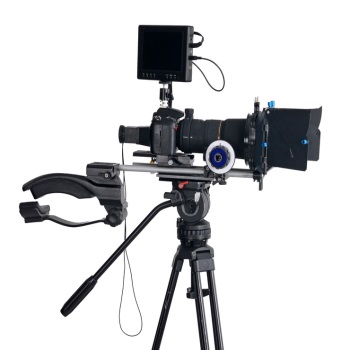How to Make a Video |
||||||||||||||||||||||
|
There are three approaches that you can take when planning a video. The first is what is called an "Empirical approach" which essentially means an unplanned format. Everything is filmed and a script is written after, making sense of that which was filmed.
|
 |
|||||||||||||||||||||
|
Phase 1 - Pre-productionDuring this phase of your production, all activities required in preparing for the shoot are covered extensively, and below are listed the different tasks that will have to be completed. Planning the videoPlanning the video is exactly what it claims to be. Start with the idea and allow time to consider aspects such as subject, time and communication goals. The subject should be easy, and when planning a running time, eight to ten minutes is ideal for a corporate video. Communication goals include what occasion the video is being created for, what message you want to convey, who is the ideal viewing audience and what is their level of expertise, or what do they already know about the company. The SkeletonDecide what needs to be covered in the video and sketch out a rough skeleton of ideas and main points that you wish to get across in the introduction, body and conclusion. Decide on an approachDuring this portion of the pre-production phase decisions need to be made and the actual production needs to be considered and planned for. Ideas may be changed and developed, and research into the project's planned scenarios needs to be taken care of. Visualize what it is that you would like to see happen on film. By visualizing you help yourself to think visually, rather than analytically. Take the time to list all possible items that may need to be filmed, also plan costing of both the actual job as well as behind the scenes costs such as crew, actors, traveling, accommodation, food and refreshments, location and permission arrangements. Writing the scriptA script needs to be written for the spoken part of the video, it is wise to invest in a professional writer or at least have a writer assist in the process. The script needs to be written in a conversational manner and needs to come across as if the information is being told, not read. Shot lists and visual preparationOnce the script has been written, a detailed shot list needs to be planned. Traditionally a shot list is formatted in a two column structure with the narration on the left and the detailed shot description next to the corresponding information on the right. It is important that the planned shot list be very detailed as well as timed so that the director has some idea of how much time he has on individual shots. All the little detailsUse this time to source stock photography and music, and remember to get copyright clearance. Plan for models, actors or on-camera presenters and their contractual requirements. Make sure that you have considered what individuals should wear, and that locations have been prepared. All parties involved need to be briefed, and anyone appearing in a shot needs to be given a time schedule. A remote survey needs to be performed and every last conceivable detail needs to be finalized. Always make allowance for a "Plan B", as all your plans may need to change on account of rain, snow or other major determining and unforeseeable factors. Plan a shooting diaryA shooting diary needs to be drafted and final element needs to be scheduled. Equipment that needs to be hired must be arranged, actors and models booked and a crew needs to be arranged and booked. A precise timeline needs to be drawn up specifying each shot, and the time allocated to it. When planning shooting days and time, traveling between locations needs to be calculated, as well as the time it takes to put up and break down equipment, sets and props. It is essential that every minute is planned for and that the crew never needs to wait for anything, in order to get the job done. Finally, planning for tasks to be performed on completion of filming need to be accounted for and time needs to be allocated for returning of equipment and other related tasks. These are all the most important factors to take into consideration when a video is in the pre-production phase of development, and once you reach this point, it is time to move on to phase two, the actual filming… It is necessary for the client to be aware of every facet of the filming day, and be fully ready to walk through every step with the crew, and to ensure that every detail that is captured on film will portray the company in the best possible light. Things to remember and prepare forWhen making a corporate video, or any video production for that matter, there are certain aspects producers don't always inform you of – the consequences of not knowing may lead to inflated and hidden cost, that if you were aware of you may have avoided.
Final thoughtThere are many intricate details involved in the production of a video, many that the client may never need to be aware of or concerned with, that the crew and producer take care of without any discussion. But, without clear communication of the client's wants and needs, the video may result in something that neither party is happy with. For the optimal outcome, arrange with your producer to sit down and make a list of all the requirements that you are expected to fulfill, and reduce the chance for disappointment.
The editing portion of the video may take longer than the pre-production phase, as it is a craft form and the editor must spend time with each shot presenting every aspect in it's best possible light. First things firstAs discussed previously in the production phase, it is most important that both the client and the producer/ editor stick to the plan. By the time the video reaches post-production, it is too late to change ideas about how you want certain things portrayed. Spur of the moment changes to the script or footage may lead to extra filming or recording requirements, all of which both delay production and inflate the costs of the video.
Be InvolvedFor the recording of the voice over the client is required to be present for technical elements, and this exercise should not be seen as an opportunity to edit the script as this should be now be completely finalised. Leaving these kinds of elements up to the director or engineer's discretion may lead to mistakes and once again inflated costs. The editor will make a rough-cut of visuals and voice-overs in sync, but will be devoid of all effects and techniques, colour matching and graphics. The music that a director intends on using may also be included. The choice of music is based on certain criteria, giving value to the video and being suitable, not over shadowing the voice artists, yet suiting the production. By doing this the editor can get some idea of whether he/she and the client have the same view of the end product in mind. Pink elephants and flying pigsThe magical world of computer animation and special effect as depicted in big budget Hollywood productions, has opened the world's eyes to just what can be done with computers and video. Even on a small corporate scale, the tools used in post-production could very well make pigs fly between the scenes, but these kinds of effects are not necessary between every scene. Sound Idea Digital is a full service Video Production Company that specialise in health & safety videos, training videos, marketing videos, corporate videos, web videos, animation and motion graphics. We also produce industrial, mining, induction, and company launch videos. | www.soundideavideoproduction.co.za | info@soundidea.co.za |
||||||||||||||||||||||

This Sound Idea Digital article provides a guide to marketing video production, covering the benefits and application....

How to use Video Production effectively in your Content Strategy by Sound Idea Digital...

Tips for Planning a Contractors Health and Safety Induction Training Video from Video Production specialists Sound Idea Digital...